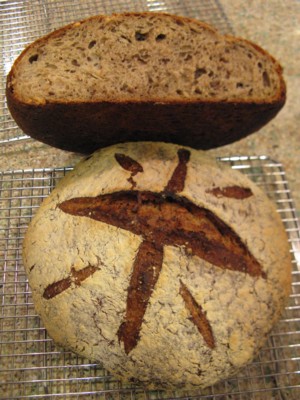Hello,
Today's bake was an experiment with multigrain, to see the difference between baking in a cold dutch oven, versus baking on my firebrick baking stone.
I've seen so many successful dutch oven bakes here on TFL - I wanted to give it a try!
The result: Very tasty! if not exactly pretty.
The baking stone loaf rose up an extra 1/2" compared to the 'cold dutch oven' loaf, which spread out more & didn't have as much oven spring/bloom from scoring.
Other variables: shaping was harder for the dutch oven loaf (fighting a sticky dough), and the dutch oven loaf was baked at a slightly lower temperature.
Crumb shot is from the 'cold dutch oven' loaf. The bottom loaf was baked on the baking stone.

I tasted a heavenly sourdough bread with sunflower, poppy and flax seeds this past week - I wanted to try and recreate that flavor - so this is the combination of seeds I used for this multigrain. The sunflower seeds were not toasted prior to soaking.
Weights, in grams, for two big boules:
|
|
Levain
|
Soaker
|
Dough
|
Total
|
Baker's %
|
|
Bread flour
|
|
|
336
|
336
|
32%
|
|
Red Fife 75% whole wheat flour
|
200
|
|
432
|
632
|
59%
|
|
75% sifted rye flour
|
|
|
96
|
96
|
9%
|
|
Rye meal
|
|
|
96
|
96
|
9%
|
|
Water
|
200
|
112
|
673
|
985
|
93%
|
|
Salt
|
|
2
|
23
|
25
|
2.35%
|
|
Starter
|
30
|
|
|
30
|
2.8%
|
|
Mixed seeds
|
|
100
|
|
100
|
9%
|
|
Levain (7 hour build at 80F)
|
|
|
430
|
|
|
|
Soaker (7 hour soak)
|
|
|
214
|
|
|
|
Total
|
430
|
214
|
2300
|
2300
|
|
*also added approximately 1 teaspoon of barley malt syrup when mixing this dough.
The ingredients are based on
Chad Robertson's Tartine Whole Grain Seeded Bread as featured In The News here on TFL (page 3), and Didier Rosada's Whole Grain Bread as featured on modern-baking.com. I am grateful to both of these talented bakers for their formulas!
Mixing, fermenting and retarding were as per Mr. Roberton's method, except I held back 90g of water to mix in with the salt and seeds after autolyse (double hydration used in Mr. Rosada's method).
Ingredients (levain, increased whole wheat flour, rye meal) were inspired by Mr. Rosada's formula.
The dough was retarded in bulk form for 12 hours, after a 3.5 hour bulk ferment at 80F.
The boules were shaped cold from the fridge; both proofed for one hour (one loaf in the dutch oven and one in a banneton).
The dutch oven was covered and placed directly on an oven rack in an oven preheated for 20 minutes at 500F. Temperature was reduced to 450F after loading the oven. The dutch oven lid was removed after 20 minutes.
The other loaf was baked on the stone with steam after the stone was preheated at 500F for 1 hour. Temperature was reduced to 460F after loading the oven.
Loaves baked for 45 minutes, then were left in oven for 10 minutes with oven off and oven door ajar.
I think this is one of the tastiest breads I've made. I really like the energy savings the dutch oven baking method provides.
Next time I'll try preheating the dutch oven and see how the oven spring is.
Happy baking everyone!
from breadsong